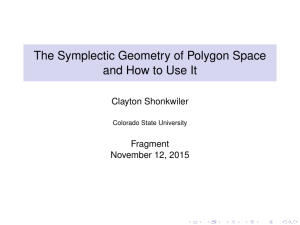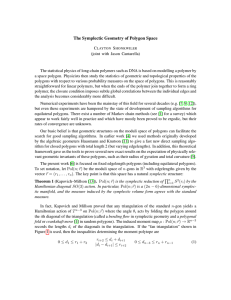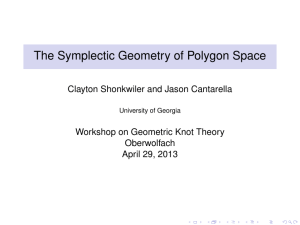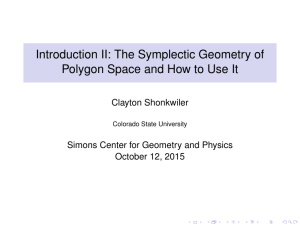The Symplectic Geometry of Polygon Space and How to Use It
advertisement
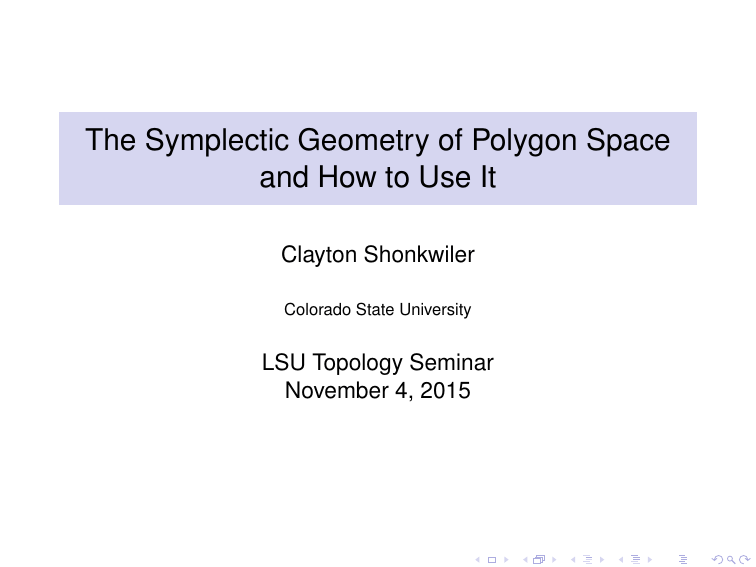
The Symplectic Geometry of Polygon Space
and How to Use It
Clayton Shonkwiler
Colorado State University
LSU Topology Seminar
November 4, 2015
From Variable Edgelengths to Fixed Edgelengths
In my grad student colloquium, I described a model for closed,
relatively framed polygons in R3 of total length 2 based on the
Grassmannian G2 (Cn ).
From Variable Edgelengths to Fixed Edgelengths
In my grad student colloquium, I described a model for closed,
relatively framed polygons in R3 of total length 2 based on the
Grassmannian G2 (Cn ).
How to specialize to unframed polygons with fixed edgelengths
(for example, equilateral polygons)?
From Variable Edgelengths to Fixed Edgelengths
In my grad student colloquium, I described a model for closed,
relatively framed polygons in R3 of total length 2 based on the
Grassmannian G2 (Cn ).
How to specialize to unframed polygons with fixed edgelengths
(for example, equilateral polygons)?
(one edge of length 1 =⇒ volume = 0)
G2 (Cn )
G2
(Cn )
(equilaterals are largest volume)
is an assembly of fixed edge length spaces
Random Polygons and Ring Polymers
Statistical Physics Point of View
A ring polymer in solution takes on an ensemble of random
shapes, with topology (knot type!) as the unique conserved
quantity.
Knotted DNA
Wassermann et al.
Science 229, 171–174
DNA Minicircle simulation
Harris Lab
University of Leeds, UK
The basic paradigm is to model these by standard random
walks conditioned on closure; i.e., equilateral random polygons.
Goals
Three main goals for this talk:
1
Describe how the moduli spaces of fixed edgelength
polygons connect with a larger symplectic geometry story.
2
Use symplectic geometry to find nice coordinates on
equilateral polygon space.
3
Give a direct sampling algorithm which generates a
random equilateral n-gon in O(n5/2 ) time.
Random Walks
Let Arm(n; ~r ) be the moduli space of random walks in R3
consisting of n steps up to translation of lengths ~r = (r1 , . . . , rn ).
Then Arm(n; ~r ) ∼
= S 2 (r1 ) × . . . × S 2 (rn ).
Random Walks
Let Arm(n; ~r ) be the moduli space of random walks in R3
consisting of n steps up to translation of lengths ~r = (r1 , . . . , rn ).
Then Arm(n; ~r ) ∼
= S 2 (r1 ) × . . . × S 2 (rn ).
Let Pol(n; ~r ) ⊂ Arm(n; ~r ) be the submanifold of closed random
walks (or random polygons); i.e., those walks which satisfy
n
X
i=1
~ei = ~0.
Some Symplectic Geometry
S 2 (r1 ) × . . . × S 2 (rn )
is a symplectic manifold and the diagonal SO(3) action is
area-preserving on each factor, so this action is by
symplectomorphisms.
Some Symplectic Geometry
S 2 (r1 ) × . . . × S 2 (rn )
is a symplectic manifold and the diagonal SO(3) action is
area-preserving on each factor, so this action is by
symplectomorphisms.
In fact, the action is Hamiltonian with corresponding moment
map µ : S 2 (r1 ) × . . . × S 2 (rn ) → R3 given by
X
~ei .
µ(~e1 , . . . , ~en ) =
Some Symplectic Geometry
S 2 (r1 ) × . . . × S 2 (rn )
is a symplectic manifold and the diagonal SO(3) action is
area-preserving on each factor, so this action is by
symplectomorphisms.
In fact, the action is Hamiltonian with corresponding moment
map µ : S 2 (r1 ) × . . . × S 2 (rn ) → R3 given by
X
~ei .
µ(~e1 , . . . , ~en ) =
Therefore, Pol(n; ~r ) = µ−1 (~0)
Some Symplectic Geometry
S 2 (r1 ) × . . . × S 2 (rn )
is a symplectic manifold and the diagonal SO(3) action is
area-preserving on each factor, so this action is by
symplectomorphisms.
In fact, the action is Hamiltonian with corresponding moment
map µ : S 2 (r1 ) × . . . × S 2 (rn ) → R3 given by
X
~ei .
µ(~e1 , . . . , ~en ) =
c ~r ) of closed
Therefore, Pol(n; ~r ) = µ−1 (~0) and the space Pol(n;
polygons up to translation and rotation is a symplectic reduction
c ~r ) = µ−1 (~0)/SO(3) = S 2 (r1 ) × . . . × S 2 (rn ) //~ SO(3).
Pol(n;
0
The Big Symplectic Picture (via Hausmann–Knutson)
U
//~r
0
//~
n
U
)
(1
(2
)
(C2 )n
Y
G2 (Cn )
0
1
//~
n−
SO
)
(1
(3
)
U
//~r
c ~r )
Pol(n;
S 2 (ri )
Some Details
A symplectic manifold (M, ω) is a smooth 2n-dimensional
manifold M with a closed, non-degenerate 2-form ω called the
symplectic form. The nth power of this form ω n = ω
. . ∧ ω} is
| ∧ .{z
n
a volume form on M.
Some Details
A symplectic manifold (M, ω) is a smooth 2n-dimensional
manifold M with a closed, non-degenerate 2-form ω called the
symplectic form. The nth power of this form ω n = ω
. . ∧ ω} is
| ∧ .{z
n
a volume form on M.
The circle U(1) acts by symplectomorphisms on M if the action
preserves ω. A circle action generates a vector field X on M.
We can contract the vector field X with ω to generate a
one-form:
ιX ω(~v ) = ω(X , ~v )
If ιX ω is exact, meaning it is dH for some smooth function H on
M, the action is called Hamiltonian. The function H is called the
momentum associated to the action, or the moment map.
Some More Details
A torus T k = U(1)k which acts by symplectomorphisms on M
so that each circle action is Hamiltonian induces a moment
map µ : M → Rk where the action preserves the fibers (inverse
images of points).
Theorem (Atiyah, Guillemin–Sternberg, 1982)
The image of µ is a convex polytope in Rk called the moment
polytope.
Theorem (Duistermaat–Heckman, 1982)
The pushforward of the symplectic measure to the moment
polytope is piecewise polynomial. If k = n = 12 dim(M), then the
manifold is called a toric symplectic manifold and the
pushforward measure is Lebesgue measure on the polytope.
Numerical cubature from Archimedes’ hat-box theorem
Greg Kuperberg∗
A Down-to-Earth Example
Department of Mathematics, University of California, Davis, CA 95616
Dedicated to Krystyna Kuperberg on the occasion of her 60th birthday
Let (M, ω) be the 2-sphere with the standard area form. Let
U(1) act by rotation around the z-axis. Then the moment
polytope is the interval [−1, 1], and S is a toric symplectic
manifold.
imedes’ hat-box theorem states that uniform measure on a sphere projects to uniform measure on an
. This fact can be used to derive Simpson’s rule. We present various constructions of, and lower bounds
merical cubature formulas using moment maps as a generalization of Archimedes’ theorem. We realize
well-known cubature formulas on simplices as projections of spherical designs. We combine cubature
2
as on simplices and tori to make new formulas on spheres. In particular Sn admits a 7-cubature formula
mes a 7-design) with O(n4 ) points. We establish a local lower bound on the density of a PI cubature
a on a simplex using the moment map.
g the way we establish other quadrature and cubature results of independent interest. For each t, we
ct a lattice trigonometric (2t + 1)-cubature formula in n dimensions with O(nt ) points. We derive a
of the Möller lower bound using vector bundles. And we show that Gaussian quadrature is very sharply
optimal among positive quadrature formulas.
1.
Theorem (Archimedes, Duistermaat–Heckman)
The pushforward of the standard measure on the sphere to the
it.) Therefore if F is a t-cubature formula on S2 , its projection
interval is 2π times
Lebesgue
measure.
π (F) is
a t-cubature formula
on [−1, 1].
INTRODUCTION
e on Rn with finite moments. A cubature
or µ is a set of points F = {!pa } ⊂ Rn and
#→ wa ∈ R such that
def
d µ = P(F) =
N
∑ wa P(!pa)
π
a=1
degree at most t. (If n = 1, then F is also
formula.) The formula F is equal-weight
ositive if all wa are positive; and negative
negative. Let X be the support of µ . The
r if every point !pa is in the interior of X;
ry !pa is in X and some !pa is in ∂ X; and
or. We will mainly consider positive, inve, boundary (PB) cubature formulas, and
that µ is normalized so that total measure
re the most useful in numerical analysis
Illustration
by Kuperberg.
Figure 1: Archimedes’ hat-box theorem.
The 2-sphere S2 has 5 especially nice cubature formulas
given by the vertices of the Platonic solids. Their cuba-
Action-Angle Coordinates are Cylindrical Coordinates
(z, θ)
√
√
( 1 − z 2 cos θ, 1 − z 2 sin θ, z)
Corollary
This map pushes the standard probability measure on
[−1, 1] × S 1 forward to the correct probability measure on S 2 .
Symplectic Reduction
Theorem (Marsden–Weinstein, Meyer)
If G is a g-dimensional compact Lie group which acts in a
Hamiltonian fashion on the symplectic manifold (M, ω) with
associated moment map µ : M → Rg , then for any ~v in the
moment polytope so that the action of G preserves the fiber
µ−1 (~v ) ⊂ M, the quotient
M //~v G := µ−1 (~v )/G
has a natural symplectic structure induced by ω. The manifold
M //~v G is called the symplectic reduction of M by G (over ~v ).
The Big Symplectic Picture (repeated)
U
//~r
0
//~
n
U
)
(1
(2
)
(C2 )n
Y
G2 (Cn )
0
1
//~
n−
SO
)
(1
(3
)
U
//~r
c ~r )
Pol(n;
S 2 (ri )
c ~r ) is Toric
Pol(n;
Given an (abstract) triangulation of the n-gon, the folds on any
two chords commute. Thus, rotating around all n − 3 of these
chords by independently selected angles defines a T n−3 action
c ~r ) which preserves the chord lengths.
on Pol(n;
c ~r ) is Toric
Pol(n;
Given an (abstract) triangulation of the n-gon, the folds on any
two chords commute. Thus, rotating around all n − 3 of these
chords by independently selected angles defines a T n−3 action
c ~r ) which preserves the chord lengths.
on Pol(n;
This action turns out to be Hamiltonian. Since the chordlengths
d1 , . . . , dn−3 are the conserved quantities, the corresponding
c ~r ) → Rn−3 given by
moment map is δ : Pol(n;
δ(P) = (d1 , . . . , dn−3 ).
The Triangulation Polytope
Definition
The lengths d1 , . . . , dn−3 obey triangle inequalities, and these
inequalities turn out to exactly determine the moment polytope
Pn (~r ) ⊂ Rn−3 .
2
d1
1
d2
0
0
1
2
The Triangulation Polytope
Definition
The lengths d1 , . . . , dn−3 obey triangle inequalities, and these
inequalities turn out to exactly determine the moment polytope
Pn (~r ) ⊂ Rn−3 .
d2 ≤ 2
2
d1
d2 ≤ d1 + 1
d1 ≤ 2
1
d2
d1 + d2 ≥ 1
0
0
d1 ≤ d2 + 1
1
2
The Triangulation Polytope
Definition
The lengths d1 , . . . , dn−3 obey triangle inequalities, and these
inequalities turn out to exactly determine the moment polytope
Pn (~r ) ⊂ Rn−3 .
(0, 2, 2)
(2, 2, 2)
d1
d2
(2, 0, 2)
d3
(0, 0, 0)
(2, 2, 0)
Action-Angle Coordinates
Definition
If Pn (~r ) is the moment polytope and T n−3 is the torus of n − 3
dihedral angles, then there are action-angle coordinates:
c ~r )
α : Pn (~r ) × T n−3 → Pol(n;
14
✓2
d1
d2
✓1
c
~
Polygons and Polytopes, Together
Theorem (with Cantarella)
α pushes the standard probability measure on Pn (~r ) × T n−3
c ~r ).
forward to the correct probability measure on Pol(n;
Polygons and Polytopes, Together
Theorem (with Cantarella)
α pushes the standard probability measure on Pn (~r ) × T n−3
c ~r ).
forward to the correct probability measure on Pol(n;
Corollary
Any sampling algorithm for Pn (~r ) is a sampling algorithm for
closed polygons with edgelength vector ~r .
Expected Value of Chord Lengths
Proposition (with Cantarella)
The expected length of a chord skipping k edges in an n-edge
equilateral polygon is the (k − 1)st coordinate of the center of
mass of the moment polytope for Pol(n; ~1).
Expected Value of Chord Lengths
Proposition (with Cantarella)
The expected length of a chord skipping k edges in an n-edge
equilateral polygon is the (k − 1)st coordinate of the center of
mass of the moment polytope for Pol(n; ~1).
n
k =2
4
1
5
17
15
14
12
461
385
1,168
960
112,121
91,035
97,456
78,400
6
7
8
9
10
3
4
5
6
7
8
17
15
15
12
506
385
1,307
960
127,059
91,035
111,499
78,400
14
12
506
385
1,344
960
133,337
91,035
118,608
78,400
461
385
1,307
960
133,337
91,035
120,985
78,400
1,168
960
127,059
91,035
118,608
78,400
112,121
91,035
111,499
78,400
97,456
78,400
Expected Value of Chord Lengths
Proposition (with Cantarella)
The expected length of a chord skipping k edges in an n-edge
equilateral polygon is the (k − 1)st coordinate of the center of
mass of the moment polytope for Pol(n; ~1).
E(chord(37, 112)) =
2586147629602481872372707134354784581828166239735638
002149884020577366687369964908185973277294293751533
821217655703978549111529802222311915321645998238455
195807966750595587484029858333822248095439325965569
561018977292296096419815679068203766009993261268626
707418082275677495669153244706677550690707937136027
424519117786555575048213829170264569628637315477158
307368641045097103310496820323457318243992395055104
≈ 4.60973
Knot Fractions
Proposition (with Cantarella)
At least 1/2 of the space of equilateral 6-edge polygons consists
of unknots.
Knot Fractions
Proposition (with Cantarella)
At least 1/2 of the space of equilateral 6-edge polygons consists
of unknots.
Despite the proposition, we observe experimentally that (with
95% confidence) between 1.1 and 1.5 in 10,000 hexagons are
knotted.
Knot Fractions
Proposition (with Cantarella)
At least 1/2 of the space of equilateral 6-edge polygons consists
of unknots.
Despite the proposition, we observe experimentally that (with
95% confidence) between 1.1 and 1.5 in 10,000 hexagons are
knotted.
How can we be so sure?
An (Incomplete?) History of Polygon Sampling
Sampling Algorithms for Equilateral Polygons:
• Markov Chain Algorithms
• crankshaft (Vologoskii 1979, Klenin 1988)
• polygonal fold (Millett 1994)
• Direct Sampling Algorithms
• triangle method (Moore 2004)
• generalized hedgehog method (Varela 2009)
• sinc integral method (Moore 2005, Diao 2011)
An (Incomplete?) History of Polygon Sampling
Sampling Algorithms for Equilateral Polygons:
• Markov Chain Algorithms
• crankshaft (Vologoskii et al. 1979, Klenin et al. 1988)
• convergence to correct distribution unproved
• polygonal fold (Millett 1994)
• convergence to correct distribution unproved
• Direct Sampling Algorithms
• triangle method (Moore et al. 2004)
• samples a subset of closed polygons
• generalized hedgehog method (Varela et al. 2009)
• unproved whether this is correct distribution
• sinc integral method (Moore et al. 2005, Diao et al. 2011)
• requires sampling complicated 1-d polynomial densities
The Fan Triangulation Polytope
(2, 3, 2)
d1
d2
d3
(0, 0, 0)
(2, 1, 0)
The polytope Pn = Pn (~1) corresponding to the “fan
triangulation” is defined by the triangle inequalities:
0 ≤ d1 ≤ 2
1 ≤ di + di+1
|di − di+1 | ≤ 1
0 ≤ dn−3 ≤ 2
A Change of Coordinates
If we introduce fake chordlength d0 = 1 = dn−2 , and make the
linear transformation
si = di − di−1 , for 1 ≤ i ≤ n − 2
P
then
si = dn−2 − d0 = 0, so sn−2 is determined by
s1 , . . . , sn−3
A Change of Coordinates
If we introduce fake chordlength d0 = 1 = dn−2 , and make the
linear transformation
si = di − di−1 , for 1 ≤ i ≤ n − 2
P
then
si = dn−2 − d0 = 0, so sn−2 is determined by
s1 , . . . , sn−3 and the inequalities
1 ≤ di + di+1
|di − di+1 | ≤ 1
0 ≤ d1 ≤ 2
0 ≤ dn−3 ≤ 2
become
−1 ≤ si ≤ 1,
|
−1 ≤
{z
|di −di+1 |≤1
n−3
X
i=1
si ≤ 1,
}
i
X
j=1
|
sj +
i+1
X
j=1
{z
sj ≥ −1
di +di+1 ≥1
}
The Key Result
Let Cn ⊂ [−1, 1]n−3 be determined by the inequalities on the
previous slide.
The Key Result
Let Cn ⊂ [−1, 1]n−3 be determined by the inequalities on the
previous slide.
C5
The Key Result
Let Cn ⊂ [−1, 1]n−3 be determined by the inequalities on the
previous slide.
C6
The Key Result
Let Cn ⊂ [−1, 1]n−3 be determined by the inequalities on the
previous slide.
C6
Theorem (with Cantarella, Duplantier, Uehara)
The probability that a point in the hypercube lies in Cn is
asymptotic to
√
6 6 1
√
.
π n3/2
The Volume of Cn
Theorem (Khoi, Takakura, Mandini)
The volume of Cn is
b /2c
X
1
k +1 n
(−1)
(n − 2k )n−3
2(n − 3)!
k
n
k =0
The Volume of Cn
Theorem (Khoi, Takakura, Mandini)
The volume of Cn is
b /2c
X
1
k +1 n
(−1)
(n − 2k )n−3
2(n − 3)!
k
n
k =0
Observation (Edwards, 1922)
Vol Cn =
2n−1
2π
Z
∞
−∞
sinn x
dx
x n−2
Asymptotic volume
√
Making the substitution x = y / n gives
Z
√ 2n−1 ∞ sin (y/ n) n y 2 dy
Vol Cn =
√
y/ n
2π −∞
n3/2
Z
n
∞ 2n−1 1
−y 2/6n
∼
e
y 2 dy
2π n3/2 −∞
Z ∞
2n−1 1
y2
e− /6 y 2 dy
=
3/2
2π n
−∞
r
3 n− 3 1
=3
2 2 3/2 .
π
n
Therefore,
Vol Cn
∼
Vol [−1, 1]n−3
3
q
3
π
3
2n− 2
2n−3
1
n3/2
√
6 6 1
= √
.
π n3/2
The Action-Angle Method
Action-Angle Method (with Cantarella, Duplantier,
Uehara)
1
2
3
Generate (s1 , . . . , sn−3 ) uniformly on [−1, 1]n−3 O(n) time
Test whether (s1 , . . . , sn−3 ) ∈ Cn acceptance ratio ∼ 1/n3/2
P
Let sn−2 = − si and change coordinates to get diagonal
lengths
4
Generate dihedral angles from T n−3
5
Build sample polygon in action-angle coordinates
Knot Types of 10 Million 60-gons
Probability
1.
1. × 10
●
Straight line: e−e n−7/4
-1
● ●
●
1. × 10-2
●●
●●●
●●●●●●●
●●
●
●
●
●
●
●
●
●
●
●
●
●
●
●
●
●
●
●
●
●
●
●
●
●
●
●
●
●
●
●
●
●
●
●
●
●
●
●
●
●
●
●
●
●
●
●
●
●
●
●
●
●
●
●
●
●
●
●
●
●
●
●
●
●
●
●
●
●
●
●
●
●
●
●
●
●
●
●
●
●
●
●
●
●
●
●
●
●
●
●
●
●
●
●
●
●
●
●
●
●
●
●
●
●
●
●
●
●
●
●
●
●
●
●
●
●
●
●
●
●
●
●
●
●
●
●
●
●
●
●
●
●
●
●
●
●
●
●
●
●
●
1. × 10-3
1. × 10-4
1. × 10-5
1. × 10-6
1
10
100
1000
HOMFLY
Knot Types of 10 Million 60-gons
Probability
1.
1. × 10
●
Straight line: e−e n−7/4
-1
● ●
●
1. × 10-2
●●
●●●
●●●●●●●
●●
●
●
●
●
●
●
●
●
●
●
●
●
●
●
●
●
●
●
●
●
●
●
●
●
●
●
●
●
●
●
●
●
●
●
●
●
●
●
●
●
●
●
●
●
●
●
●
●
●
●
●
●
●
●
●
●
●
●
●
●
●
●
●
●
●
●
●
●
●
●
●
●
●
●
●
●
●
●
●
●
●
●
●
●
●
●
●
●
●
●
●
●
●
●
●
●
●
●
●
●
●
●
●
●
●
●
●
●
●
●
●
●
●
●
●
●
●
●
●
●
●
●
●
●
●
●
●
●
●
●
●
●
●
●
●
●
●
●
●
●
●
1. × 10-3
1. × 10-4
1. × 10-5
1. × 10-6
1
10
100
1000
HOMFLY
We sampled 10 million 60-gons and computed their HOMFLY
polynomials. 42 of the 60-gons were numerically singular, but
the rest yielded 6371 distinct HOMFLY polynomials.
Questions
Algebraic Geometry and Measures
n
)
//G
L(
2,
C
∗
C
//(
)
(C2 )n
Y
∗
L(
2,
C
//(
//P
G
1
n−
)
Question
(CP1 )n
C)
G2 (Cn )
c ~r )
Pol(n;
c ~r )?
How to use algebraic geometry to understand Pol(n;
Symplectic Geometry and Excluded Volume
Question
How to incorporate excluded volume into the model?
Topologically Constrained Random Walks
Tezuka Lab, Tokyo Institute of Technology
Question
What special geometric structures exist on the moduli space of
topologically-constrained random walks patterned on a given
graph?
A Theory of Piecewise-Linear Submanifolds
Question
Is there a generalization to a geometric theory of (immersed)
closed piecewise-linear surfaces in R3 ? Or, more generally,
closed PL k-manifolds in Rn ?
Thank you!
Thank you for listening!
References
• The Symplectic Geometry of Closed Equilateral Random
Walks in 3-Space
Jason Cantarella and Clayton Shonkwiler
Annals of Applied Probability, to appear.
• A Fast Direct Sampling Algorithm for Equilateral Closed
Polygons
Jason Cantarella, Bertrand Duplantier, Clayton Shonkwiler,
and Erica Uehara
arXiv:1510.02466
http://shonkwiler.org

